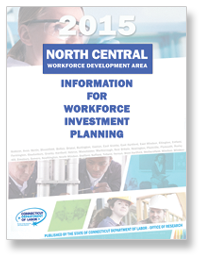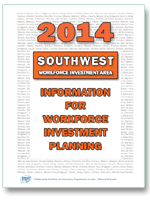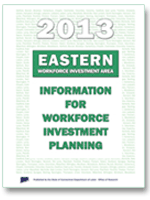

|

|

|

|
| Home | About | Publications | FAQ | Glossary | Contact |
 |
| Information for Workforce Investment Planning - State of Connecticut | Last Updated: November 4th, 2025 |
|
The Connecticut Department of Labor's Office of Research is the state's leading producer of information
and statistics on the economy, workforce, occupations, and careers. Our mission is to produce, analyze, and deliver timely and reliable workforce information and statistics to assist in decision-making for those planning economic development initiatives, for education and training providers, and for job seekers and students who are seeking guidance in making career choices.
In support of these efforts, the Office of Research is pleased to provide the 2018 Information for Workforce Investment Planning. This publication contains a variety of data on Connecticut and each of the state's five Workforce Development Areas including population and population density, labor force, employment and wages by industry sector, and new housing permits. In addition, detailed information on residents in need of workforce investment services such as high school dropouts, Medicaid recipients, adult probationers, Temporary Family Assistance (TFA) recipients, and other residents with barriers to employment is included. The 2018 Information for Workforce Investment Planning also includes appendix tables and historical data on the aforementioned topics for comparisons and trends analysis. Data sources are cited on each appendix table, which includes other State agencies, the Connecticut Department of Labor and the U.S. Census Bureau. We wish to thank all of the data providers for their contribution to this year's publication. The charts and tables in the 2018 Information for Workforce Investment Planning are within the public domain, and may be copied and/or quoted. However, we do request that you attribute such material to this publication. |
We hope that you find the 2018 Information for Workforce Investment Planning an effective data source for your planning needs.
 Resources:
Resources:
 (Effective May 2016)
(Effective May 2016) | ||||||||||||||||
| Archived Information for Workforce Investment Planning Documents | ||||||||||||||||
 | ||||||||||||||||
 |
2017 Information for Workforce Investment Planning This publication contains a variety of data on Connecticut and each of the state�s five Workforce Development Areas including population and population density, labor force, employment and wages by industry sector, and new housing permits. In addition, detailed information on residents in need of workforce investment services such as high school dropouts, Medicaid recipients, adult probationers, Temporary Family Assistance (TFA) recipients, and other residents with barriers to employment is included. The 2016 Information for Workforce Investment Planning also includes appendix tables and historical data on the aforementioned topics for comparisons and trends analysis. | |||||||||||||||
 |
||||||||||||||||
 | ||||||||||||||||
 |
2016 Information for Workforce Investment Planning This publication contains a variety of data on Connecticut and each of the state�s five Workforce Development Areas including population and population density, labor force, employment and wages by industry sector, and new housing permits. In addition, detailed information on residents in need of workforce investment services such as high school dropouts, Medicaid recipients, adult probationers, Temporary Family Assistance (TFA) recipients, and other residents with barriers to employment is included. The 2016 Information for Workforce Investment Planning also includes appendix tables and historical data on the aforementioned topics for comparisons and trends analysis. | |||||||||||||||
 |
||||||||||||||||
 | ||||||||||||||||
 |
 |
2015 Information for Workforce Investment Planning This publication contains a variety of data on Connecticut and each of the state�s five Workforce Development Areas including population and population density, labor force, employment and wages by industry sector, and new housing permits. In addition, detailed information on residents in need of workforce investment services such as high school dropouts, Medicaid recipients, adult probationers, Temporary Family Assistance (TFA) recipients, and other residents with barriers to employment is included. The 2015 Information for Workforce Investment Planning also includes appendix tables and historical data on the aforementioned topics for comparisons and trends analysis. |
||||||||||||||
 |
| |||||||||||||||
 | ||||||||||||||||
 |
 |
2014 Information for Workforce Investment Planning This publication contains a variety of data on Connecticut and each of the state�s five Workforce Investment Areas including population and population density, labor force, employment and wages by industry sector, and new housing permits. In addition, detailed information on residents in need of workforce investment services such as high school dropouts, Medicaid recipients, adult probationers, Temporary Family Assistance (TFA) recipients, and other residents with barriers to employment is included. Includes appendix tables and historical data on the aforementioned topics for comparisons and trends analysis. | ||||||||||||||
 |
| |||||||||||||||
 | ||||||||||||||||
 |
 |
2013 Information for Workforce Investment Planning This publication contains a variety of data on Connecticut and each of the state’s five Workforce Investment Areas including population and population density, labor force, employment and wages by industry sector, and new housing permits. In addition, detailed information on residents in need of workforce investment services such as high school dropouts, Medicaid recipients, adult probationers, Temporary Family Assistance (TFA) recipients, and other residents with barriers to employment is included. Includes appendix tables and historical data on the aforementioned topics for comparisons and trends analysis. | ||||||||||||||
 |
||||||||||||||||
 | ||||||||||||||||
 |
 |
2012 Information for Workforce Investment Planning This publication contains a variety of data on Connecticut and each of the state’s five Workforce Investment Areas including population and population density, labor force, employment and wages by industry sector, and new housing permits. In addition, detailed information on residents in need of workforce investment services such as high school dropouts, Medicaid recipients, adult probationers, Temporary Family Assistance (TFA) recipients, and other residents with barriers to employment is included. Includes appendix tables and historical data on the aforementioned topics for comparisons and trends analysis. | ||||||||||||||
 |
||||||||||||||||
 | ||||||||||||||||
 | ||||||||||||||||
 | ||||||||||||||||
 |
 |
2011 Information for Workforce Investment Planning publication contains a variety of data on Connecticut and each of the state’s five Workforce Investment Areas including population and population density, labor force, employment and wages by industry sector, and new housing permits. In addition, detailed information on residents in need of workforce investment services such as high school dropouts, Medicaid recipients, adult probationers, Temporary Family Assistance (TFA) recipients, and other residents with barriers to employment is included. New this year is information on commuting patterns, long-term unemployment insurance claimants, and a work area profile for each WIA.
|
 |
 |
 |
2010 Information for Workforce Investment Planning contains a variety of data on Connecticut and each of the state’s five Workforce Investment Areas including population and population density, labor force, employment and wages by industry sector, and new housing permits. In addition, detailed information on residents in need of workforce investment services such as high school dropouts, Medicaid recipients, adult probationers, Temporary Family Assistance (TFA) recipients, and other residents with barriers to employment.
|
||||||||||
 | ||||||||||||||||
 | ||||||||||||||||
 | ||||||||||||||||
 |
 |
2009 Information for Workforce Investment Planning Includes a variety of data on Connecticut and each of the state’s five Workforce Investment Areas including population and population density, labor force, employment and wages by industry sector, and new housing permits. In addition, detailed information on residents in need of workforce investment services such as high school dropouts, Medicaid recipients, adult probationers, Temporary Family Assistance (TFA) recipients, and other residents with barriers to employment.
|
 |
 |
 |
2008 Information for Workforce Investment Planning Includes data on Connecticut’s population, the labor force, industry employment and wages, employment by town—which includes each town’s top employing industry (new this year), and on persons with barriers to employment. In this current edition, we’ve added highlights of Connecticut’s statewide occupational forecast, 2006 to 2016, along with additional historical data for comparisons and trends.
|
||||||||||
 | ||||||||||||||||
 |
||||||||||||||||
 | ||||||||||||||||
 |
 |
2007 Information for Workforce Investment Planning Includes data on Connecticut’s population, its labor force, industry employment and wages, employment by town, and on persons with barriers to employment. In this current edition, we’ve added 2006 data on employment by industry clusters and their relative importance statewide and for each workforce investment area; home sales and median home prices, housing inventory and fair market rents; highlights of Connecticut’s regional occupational forecast, 2004 to 2014; along with additional historical data for comparisons and trends.
|
 |
 |
 |
2006 Information for Workforce Investment Planning This publication includes data on the labor force, industry employment and wages, population, and on persons with barriers to employment. Also included this year are highlights of Connecticut’s regional occupational forecast, 2002 – 2012, and the statewide occupational outlook, 2004 – 2014. We believe this information will be useful for the Workforce Investment Board planners and policy makers who make critical workforce system decisions.
|
||||||||||
 | ||||||||||||||||
 |
||||||||||||||||
 | ||||||||||||||||
 |
 |
2005 Information for Workforce Investment Planning In addition to data on the labor force, industry employment and wages, population, and persons with barriers to employment, this year’s publication contains several new data items, including: Occupations in Demand, based on Connecticut Occupational Forecast, 2002 - 2012, Connecticut and WIA Industry Clusters, Home Ownership (Owner/Renter-Occupied Housing), and Youth Population. We believe these additional data items will be extremely useful for the Workforce Investment Board planners and policy makers who make critical workforce system decisions.
|
 |
 |
 |
2004 Information for Workforce Investment Planning In addition to data on the labor force, industry employment and wages, population, and persons with barriers to employment, this year’s publication contains several new data items, including: Commuting Patterns, Poverty Status by Town and Workforce Investment Area, Education Levels and Languages Spoken At Home, and the Characteristics of the CTWorks Clients by Jobs First Employment Services (JFES), Wagner-Peyser and Workforce Investment Act. We believe these additional data items will be extremely useful for the Workforce Investment Board planners and policy makers who make critical workforce system decisions.
|
||||||||||
 | ||||||||||||||||
 |
||||||||||||||||
 | ||||||||||||||||
 |
 |
2003 Information for Workforce Investment Planning Included are labor force data, employment and wages by industry, occupational employment trends, population changes, data on public aid recipients, high school dropout rates, and persons with other barriers to employment. The data is based on information from several State agencies, as well as the Connecticut Department of Labor. The Information for Workforce Investment Planning – 2003 has been updated and redesigned to include bar charts and additional data tables. Lengthy narratives were replaced with more effective data “bullets.” We believe this easy-to-use format will enable the Workforce Investment Board planners to more efficiently find pertinent information.
|
 |
 |
 |
2002 Information for Workforce Investment Planning Data on residents in need of workforce investment services, including public aid recipients, high school dropout rates, and persons with other barriers to employment, are based on information from several State agencies, as well as the Connecticut Department of Labor. A number of changes are taking place in the collection of labor market information and how the data is reported. Major coding system changes include the shift in industry classification from the Standard Industrial Classification (SIC) system to the North American Industry Classification System (NAICS). This is the last year that employment data is being provided using the SIC, a system last updated in 1987. Employment data is now being collected, and will be reported, under NAICS.
| ||||||||||
 | ||||||||||||||||
| The software required to view and print Adobe Acrobat (PDF) documents, such as those available here, is available for free from the Adobe Web site. | ||||||||||||||||
|
State of Connecticut Department of Labor - Office of Research, 200 Folly Brook Boulevard, Wethersfield, CT 06109
LMI Home | CTDOL Home | Feedback | This workforce product was funded by a grant awarded by the U.S. Department of Labor's Employment and Training Administration. (more) |

|
About CT | Policies | Accessibility | Directories | Social Media | For State Employees |